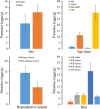Seasonal dynamics of parasitism and stress physiology in wild giant pandas
- PMID: 33014375
- PMCID: PMC7521442
- DOI: 10.1093/conphys/coaa085
Seasonal dynamics of parasitism and stress physiology in wild giant pandas
Abstract
Many factors, including the inner status of the individuals and external environment, can influence the parasite infections and stress physiology in mammals. Here, we explored the influence of the sex, age, reproductive season and seasonal food availability on the parasitism and stress physiology in wild giant pandas (Ailuropoda melanoleuca) through nutrient and steroid hormone analysis and parasitic infection measurement. Diet composition had significant influences on the faecal cortisol levels and parasite load of wild giant pandas. The seasonal dynamic of the cortisol levels and parasite load in faeces co-vary with the seasonal nutrient intake levels of the pandas, which concurrently arrived the peaks at the wood bamboo shoot-eating period in May (parasite infection intensity, 41.47 ± 12.11 eggs/g of wet faeces; cortisol levels, 619.34 ± 70.55 ng/g dry faeces) that the nutrition intake by wild pandas was the highest (protein/fibre, 69.23 ± 9.93). Meanwhile, age class is also as an important factor to affect the parasite load and stress physiology of wild giant pandas. Cubs and sub-adults suffered more helminth burden and stress physiology than adults and old individuals. This is the first study to evaluate the inner and external factors influence on parasitism and stress physiology in wild giant pandas. The findings facilitate a better understanding of how environmental factors might influence the physiology, behaviour and health of pandas and other species and have implications for the conservation and management of the endangered species.
Keywords: Faecal cortisol levels; giant panda; nutrition; parasites; stress physiology.
© The Author(s) 2020. Published by Oxford University Press and the Society for Experimental Biology.
Figures




Similar articles
-
Assessment of stress levels and reproductive condition in giant pandas: insights from hair, faecal and saliva samples.Conserv Physiol. 2024 Jul 3;12(1):coae044. doi: 10.1093/conphys/coae044. eCollection 2024. Conserv Physiol. 2024. PMID: 38962510 Free PMC article.
-
Review on parasites of wild and captive giant pandas (Ailuropoda melanoleuca): Diversity, disease and conservation impact.Int J Parasitol Parasites Wildl. 2020 Jul 28;13:38-45. doi: 10.1016/j.ijppaw.2020.07.007. eCollection 2020 Dec. Int J Parasitol Parasites Wildl. 2020. PMID: 32793415 Free PMC article. Review.
-
Baylisascaris schroederi Infection in Giant Pandas (Ailuropoda melanoleuca) in Foping National Nature Reserve, China.J Wildl Dis. 2017 Oct;53(4):854-858. doi: 10.7589/2016-08-190. Epub 2017 Jul 12. J Wildl Dis. 2017. PMID: 28700323
-
What determines selection and abandonment of a foraging patch by wild giant pandas (Ailuropoda melanoleuca) in winter?Environ Sci Pollut Res Int. 2009 Jan;16(1):79-84. doi: 10.1007/s11356-008-0066-4. Epub 2008 Nov 4. Environ Sci Pollut Res Int. 2009. PMID: 18982373
-
Conservation Genomics and Metagenomics of Giant and Red Pandas in the Wild.Annu Rev Anim Biosci. 2024 Feb 15;12:69-89. doi: 10.1146/annurev-animal-021022-054730. Epub 2023 Oct 20. Annu Rev Anim Biosci. 2024. PMID: 37863091 Review.
Cited by
-
Intestinal Parasites and Fecal Cortisol Metabolites in Multi-Unowned-Cat Environments: The Impact of Housing Conditions.Animals (Basel). 2021 Apr 30;11(5):1300. doi: 10.3390/ani11051300. Animals (Basel). 2021. PMID: 33946549 Free PMC article.
-
Assessment of stress levels and reproductive condition in giant pandas: insights from hair, faecal and saliva samples.Conserv Physiol. 2024 Jul 3;12(1):coae044. doi: 10.1093/conphys/coae044. eCollection 2024. Conserv Physiol. 2024. PMID: 38962510 Free PMC article.
-
Blood cortisol and faecal cortisol metabolite concentrations following an ACTH challenge in unanaesthetized brown bears (Ursus arctos).Conserv Physiol. 2025 Jan 15;13(1):coae093. doi: 10.1093/conphys/coae093. eCollection 2025. Conserv Physiol. 2025. PMID: 39816213 Free PMC article.
References
-
- Anderson RM, May RM (1982) Coevolution of hosts and parasites. Parasitology 85: 411–426. - PubMed
-
- Beldomenico PM, Begon M (2010) Disease spread, susceptibility and infection intensity: vicious circles? Trends Ecol Evol 25: 21–27. - PubMed
-
- Beldomenico PM, Begon M (2015) Stress-host-parasite interactions: a vicious triangle? FAVE Cs. Veterinarias 14: 6–19.
LinkOut - more resources
Full Text Sources

